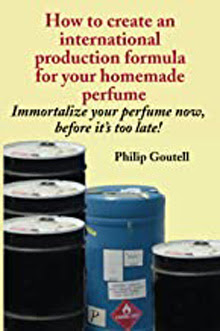I can claim more success with and perhaps more interest in men's fragrances that those I've done for women. And I can claim more success at achieving lower production costs for my men's fragrances against those I've done for women. The reason for these lower costs is the bottle. (See examples here.)
For a man's fragrance you don't need a spray and a fine mist spray pump, purchased in only hundreds or thousands rather than tens of thousands, can represent a large chunk of the product's total cost. Using a screw-on cap rather than a spray represents a huge cost saving. So, for this article, I'll rule out any use of a spray. Perhaps we can deal with that another day.
Because our interest is in bottles that can be sealed with a screw-on cap, we will only be discussing bottles with a "continuous thread" neck -- bottles with threaded necks that allow the use of a screw-on "closure," in this case a screw-on cap. Caps are generally made of plastic and can be ribbed or smooth. Ribbed caps have vertical grooves and provide a better grip.
Overall considerations
Selecting a bottle for a men's fragrance involves finding a glass bottle you like that has the capacity you want and can be purchased at a good price in the quantity you need.Your decision on capacity is important. The more than goes into the bottle, the more it will cost to fill it. Filling a 2-ounce bottle will be twice as expensive as filling a 1-ounce bottle. While this is obvious to any accountant, a creative mind can sometimes get carried away by the particular shape -- the "look" -- of a bottle and fail to notice that, due to its size, filling it will blow the budget.
Neck configuration ("finish")
While all bottles under discussion take a screw-on cap, in addition to capacity, two issues must be addressed: finding caps that are an exact fit for the neck and the opening in the neck.The cap issue involves what is called "finish," the configuration of the neck of the bottle. That configuration is defined both by the diameter of the neck, the height of the neck, and by the arrangement of the threads in the neck. To fit properly, the cap size must be an exact match with the neck size, both in diameter, neck height, and thread configuration. You will see the neck of a "continuous thread" bottle described by such designations as "15/425," "18/425," "20/410," etc. Caps for these bottles will be described using the same system.
In selecting your bottle it is important to be sure you will be able to purchase the needed supply of screw-on caps in a matching size. When you need a relatively small quantity of caps, a few hundred or perhaps a thousand or so, it is not always easy to find the caps you want in the size you need.
If you are buying a significant number of bottles and caps it is wise to get samples, before you make your purchase, and test to be sure the caps screw onto the bottles easily and, when filled, the bottles do not leak.
Sprinkler neck bottles
There is yet one more complication that must be addressed: the opening in the bottle's neck. Bottles with a special constricted opening are referred to as "sprinkler neck" because the constricted neck prevents the fragrance from pouring out and, instead, allows it to be splashed or sprinkled. Without this constriction in the neck the user would get a waterfall of fragrance instead of just a dash.In my book, Creating Your Own Fragrance With A 1700 Percent Markup!, I describe a successful project with a men's cologne and, for that project, we used a 1-ounce sprinkler neck bottle. Thanks to shopping for that bottle I became very familiar with sprinkler neck bottles and now, when shopping for a bottle for a men's cologne, my first question is, "does it have a sprinkler neck?" If so, assembly becomes very simple as the only components are the bottle and the cap.
Orifice reducer plugs
But suppose you have your heart set on a bottle that does not have a sprinkler neck? Unless you can cut down the flow that is dispensed, you can't use it. When your customer opens it up it would pour fragrance and clearly this is unacceptable.But there is a solution -- the orifice reducing plug. This is a plastic plug with a small opening that is inserted into the neck of the bottle. Not only can it give your bottle sprinkler neck utility, since these plugs are available with different size openings, you can select the amount of fragrance you want released when your customer splashes or sprinkles your cologne.
The downside of the orifice reducing plug is that it must be pressed into the bottle's neck and this takes a bit of force. You might not want to fit a large number of this plugs by hand.
When using an orifice reducing plug, and I do use them with one particular bottle I acquired in a large quantity at a very good price from a surplus bottle distributor, I use a jig I built that is a bit like the corker used by wine makers to insert a cork into the neck of a bottle. You line up the plug with the bottle, pull the lever, and the plug is squeezed into the neck.
Orifice reducing plugs are a practical solution to retro fit an open neck bottle to mimic the action of a sprinkler neck bottle but, if you are doing the bottling yourself, by hand, and you have more than a few hundred bottles to seal, the sprinkler neck bottle is by far the more efficient solution.

